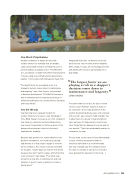Page 281 - MM2019
P. 281
One Word: Polyethelene
Weather endurance is always an issue with
outdoor furniture so materials that are durable, easily cleaned and include a UV-inhibited color to prevent fading is a popular choice. POLYWOOD’s line, as example, is made from lumber manufactured in-house using recycled high-density polyethelene plastics. It’s the same stuff milk jugs are made from.
“The largest factor we see playing a role in a shopper’s decision comes down to maintenance and longevity,” says Jenni Owens, vice president
of business development. “POLYWOOD furniture is built to withstand all four seasons and a range of climates including hot sun, snowy winters, salt spray and heavy winds.”
Into the Woods
Teak has long been a popular medium for
outdoor furniture for a reason, says Tad Varga of Three Birds Casual. He keeps a set of his company’s teak furniture outside his northern Indiana home year round. Occasionally, he’ll show a photo of the dining set buried under a few feet of snow to emphasize its durability.
Because teak grows in hot, humid climates in the Southern Hemisphere, the wood has a naturally high density of oil that keeps it supple in even the worst conditions. As a result, it can last untreated for decades. “Cruise ships use teak for their decks because they don’t want to replace all their flooring every few years,” says Varga. “They know teak
will last for a long time in extremely hot and cold climates. It doesn’t crack or splinter or rot like a typical wood.”
Varga adds that some consumers use a teak protector, but only for looks and not durability. More people, he says, are eschewing protectors and allowing the wood to age naturally into a gray shade.
“The largest factor we see playing a role in a shopper’s decision comes down to maintenance and longevity.”
JENNI OWENS
The same holds true for Ipe, the type of wood Jensen Leisure Furniture features in many of
its collections. “Ipe is really prominent in the outdoor decking industry because of the density of the wood,” says Jensen’s Todd Crandall. “Ipe is about twice the density of teak and almost twice as heavy. It’s impervious to insects and other things that can damage the wood, and it’s very smooth.” That look and durability matters to consumers, he says.
The ipe wood Jensen uses is Forest Stewardship Council certified, meaning the timber is selectively harvested in an environmentally
safe way. Crandall says the company knows
the chain of custody of each piece of wood it uses, going all the way back to the forest. >
AmericasMart.com | 259


